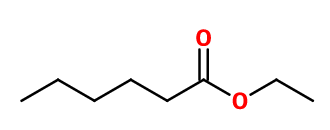Ethyl Caproate
Naturelle - Synthétique
Fruity > Tropical Fruits > Butyric

Crédits photo: ScenTree SAS
Other names :
Ethyl Hexanoate ; Hexanoic acid ethyl ester ; Ethyl hexoate
Volatility :
Head
Uses in perfumery :
Ethyl Caproate is used in exotic, fruity, tropical fruits and yellow fruits notes to ripen fruits. Also used in cheese notes, fruity and floral accords. Can accompany aldehydes in a rose accord.
Natural availability :
Ethyl Caproate is present in many fruits such as apple, guava or banana and in some cheeses, among others. There is also an Ethyl Caproate of natural origin.
Year of discovery :
Data not available.
Other comments :
Data not available.
Price Range :
€
Stability :
May form caproic acid through time

Crédits photo: ScenTree SAS
- Molecular formula :
- C8H16O2
- Molecular Weight :
- 144,21 g/mol
- Density :
- 0,869
- Flash Point :
- 53°C
- Fusion Point :
- Donnée indisponible.
- Appearance :
- Colorless liquid
- Log P :
- 2,8
- Boiling Point :
- 168°C
- Detection Threshold :
- De l'ordre de 0,3 à 5 ppb (0,0000005% !) selon les personnes
Synthesis route :
Ethyl Caproate is synthesized by an esterification reaction between Hexanoic Acid and ethanol, using acid catalysis.
Synthesis precursor :
Ethyl Caproate is not a precursor to the synthesis of another compound of olfactory interest.
Isomerism :
Ethyl Caproate does not have any isomer used in perfumery.
- EINECS number :
- 204-640-3
- FEMA number :
- 2439
- JECFA number :
- 31
- FLAVIS number :
- 09.060
- Allergens :
- This ingredient does not contain any allergen.
- IFRA :
- This ingredient is not restricted
To learn more about IFRA's standards : https://ifrafragrance.org/safe-use/library
ScenTree is solely responsible for the information provided here.

